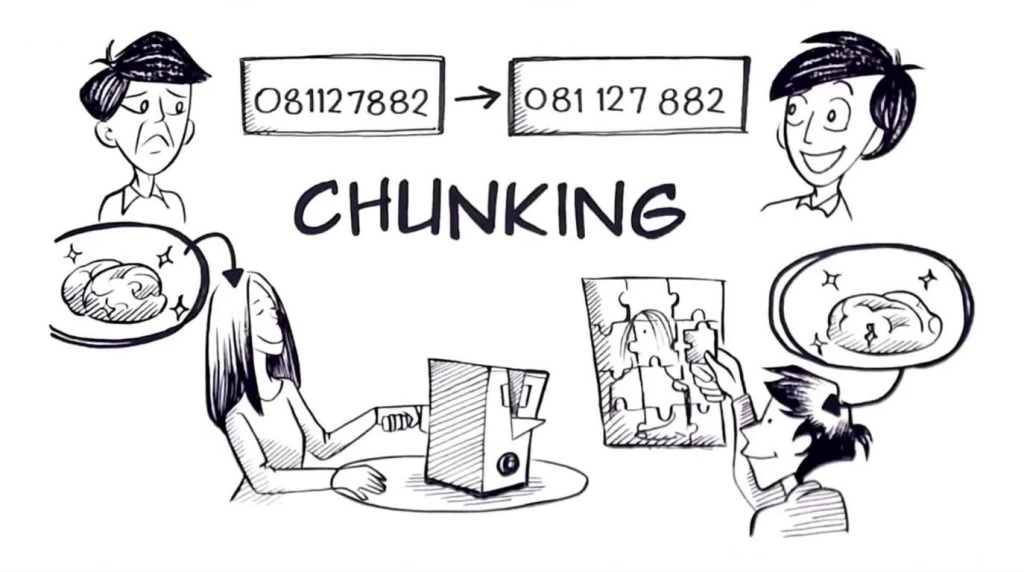Have you ever wondered how polyglots manage to speak multiple languages so effortlessly? One of their best-kept secrets isn’t flashy or complicated—it’s a simple cognitive technique known as chunking.
Instead of memorizing individual words, experienced language learners group vocabulary into meaningful phrases or “chunks” that reflect how language is naturally used. This approach not only boosts memory retention but also accelerates fluency and improves comprehension.
Scientific research supports chunking. Our brains hold about four to seven items in working memory, but this capacity expands when those items are grouped meaningfully (Cowan, 2001). In language learning, chunking helps you recall and produce expressions quickly and confidently.
What Is Chunking?
Chunking is a strategy that groups information into larger, meaningful units. In language learning, this means learning short phrases like “I’m hungry” or “How’s it going?” as single items.
Examples of common chunks:
- “Let me think about it.”
- “Do you want to…?”
- “What do you think?”
Psychologist George A. Miller introduced this concept in 1956, showing that short-term memory holds around seven items (Miller, 1956). Later studies refined this to four meaningful units (Cowan, 2001). In language, a chunk counts as one unit, making recall more efficient.
The Science Behind Chunking
Working Memory & Cognitive Load
Our brains are wired for efficiency. Cognitive Load Theory explains that when we’re overloaded with new information, learning suffers (Sweller, 1988). Chunking reduces that load.
What Research Says
- Formulaic language—stored and retrieved as chunks—is central to how native speakers communicate (Wray, 2002).
- Learners using chunk-based instruction showed improved fluency and vocabulary retention (Boers et al., 2014).
- Chunks lower the cognitive demands of grammar and syntax (Ellis, 2001).
Practical Examples of Chunking
Conversational Chunks
- “What do you mean?”
- “I’ll be right there.”
- “You’ve got to be kidding!”
Grammatical Chunks
- “I’m used to + verb-ing” → “I’m used to waking up early.”
- “Have you ever + past participle?” → “Have you ever tried skiing?”
Thematic Chunks
- At a restaurant: “Can I get this to go?”, “The check, please.”
- At work: “Let’s circle back on that.”, “What’s the deadline?”

Why Polyglots Love Chunking
✅ Speeds up speaking
You speak in pre-packaged units, reducing hesitation.
✅ Boosts listening comprehension
Chunks help you recognize meaning faster in spoken language.
✅ Builds natural grammar use
No need to consciously recall every rule—chunks embed grammar patterns.
✅ Mimics native usage
Formulaic expressions dominate natural speech (Wray, 2002).
How to Apply Chunking in Your Study Routine
Step-by-Step Strategy
- Start with common expressions
- Use real content to find natural chunks (TV shows, podcasts)
- Create a “chunk bank” with spaced repetition tools like Aprelendo, Anki, or Quizlet
- Use chunks in conversation, writing, and shadowing
Common Mistakes to Avoid
🚫 Memorizing overly long chunks
🚫 Skipping pronunciation and prosody
🚫 Learning chunks out of context
🚫 Failing to revisit and recycle chunks regularly
How Aprelendo Facilitates Chunking Through Total Reading
Aprelendo’s Total Reading methodology incorporates several features that naturally promote chunking:
- Contextual Reading: By engaging with short, level-appropriate texts, learners encounter vocabulary and phrases within meaningful contexts, aiding in the recognition of common language chunks.
- Integrated Skills Practice: Total Reading involves multiple phases—reading, listening, speaking, dictation, and review—allowing learners to reinforce chunks through various modalities, enhancing retention and fluency.
- Focus on Comprehension: The method emphasizes understanding the overall meaning of texts before delving into specific words or phrases, aligning with the chunking strategy of grasping larger language units.
- Interactive Tools: Aprelendo provides features like instant dictionary lookups and learning status cues for words, enabling learners to identify and focus on unfamiliar chunks within the text.
Conclusion
Chunking turns language learning from a slow, linear process into an intuitive, accelerated experience. It lets you speak faster, remember more, and sound more natural—all backed by cognitive science.
So next time you study, think in phrases, not words. Find a few good chunks, repeat them aloud, and build your fluency brick by brick.

Leave a Reply